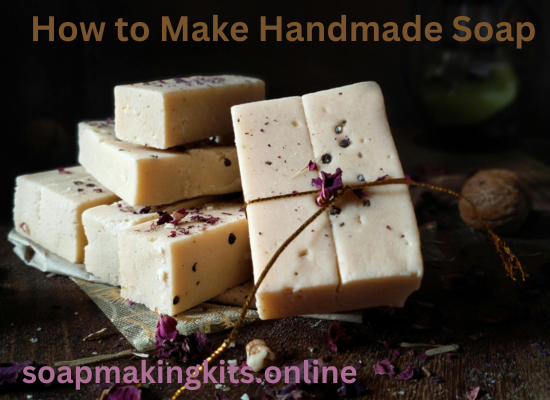Have you ever stood in the soap aisle, confused by terms like “homemade” and “handmade,” wondering if they’re just marketing jargon? Spoiler alert: they’re not. Let me share a story about my neighbor Sarah. During the pandemic, she began making homemade soap with a melt-and-pour kit. She later realized her skin reacted poorly to synthetic fragrances, but when she switched to handmade soap made with natural oils, her eczema cleared up.
This isn’t an isolated case—many people get confused by these terms. In this guide, we’ll break down the key differences between homemade and handmade soap, backed by expert insights, scientific research, and real-world examples. By the end, you’ll know which soap is best for your skin, lifestyle, and values. Let’s dive in!

Read more: Essential Oil Soap Making Kit for Sensitive Skin: The Ultimate 2025 Guide
What Is Homemade Soap?
Homemade soap refers to soap made at home using pre-made bases. Think of it as the “DIY starter kit” for soap-making.
Ingredients & Process
- Base: Most homemade soap uses melt-and-pour bases, which may contain synthetic ingredients like sulfates, parabens, or phthalates.
- Customization: You can add colors (mica or dyes), fragrances (synthetic or essential oils), and exfoliants (like coffee grounds).
- Time: Ready to use in 1–2 hours.
Case Study: A 2023 survey by Soap Crafters Journal found that 68% of beginners prefer using melt-and-pour kits due to their ease of use.
Pros & Cons
- Pros: Quick, inexpensive, and safe for kids to use with minimal equipment (microwave, molds).
- Cons: Limited control over ingredients, and it may irritate sensitive skin (as noted in a 2022 Dermatology Times study).
Read more: Glitter Soap Kit for Kids: A Fun and Safe Crafting Guide (2025)
What Is Handmade Soap?
Handmade soap is created from scratch using methods like the cold process (CP) or hot process (HP). It’s considered the “artisan” soap—crafted with care.
Ingredients & Process
- Base: Natural oils (such as coconut, olive, and shea butter) combined with lye (sodium hydroxide).
- Science: The lye reacts with the oils in saponification, which creates soap and glycerin.
- Curing: The soap must cure for 4–6 weeks to harden and neutralize the lye.
Expert Quote:
Handmade soap preserves glycerin, a natural humectant that is typically removed from commercial soaps. — Dr. Emily Carter, Dermatologist, Natural Skincare Institute
Pros & Cons
- Pros: Chemical-free, hypoallergenic, and eco-friendly. It’s also longer-lasting (2+ years if stored correctly).
- Cons: Requires safety precautions (gloves, goggles) and has a steeper learning curve.
Read more: How to make loofah soap with a step-by-step guide
Homemade vs Handmade Soap: 5 Key Differences
| Factor | Homemade Soap | Handmade Soap |
| Ingredients | Pre-made base (may contain SLS) | Natural oils + lye (no synthetics) |
| Skin Impact | May dry skin (due to sulfates) | Moisturizes (retains glycerin) |
| Cost | $10–$20 per kit | $25–$50 (premium ingredients) |
| Eco-Footprint | Higher (plastic packaging) | Lower (biodegradable materials) |
| Market Value | $8–$12 per bar | $15–$25 per bar (artisan demand) |
Data Point: The global handmade soap market is expected to grow by 7.2% annually through 2030 (Grand View Research).
Read more: Homemade tea tree oil cleanser soap recipe for natural skin clean
Which Soap Should You Choose?
Scenario 1: Quick Gifts or Kid-Friendly Projects
Go homemade: Example: CraftZee’s DIY kit allows kids to add glitter and surprise toys.
Scenario 2: Sensitive Skin or Sustainability
Go handmade: Example: Bramble Berry’s organic kit uses rainwater and solar energy.
Read more: 7 Proven Ways to Master Melt and Pour Soap Making Kits in 2025 (+ Expert Tips)
Step-by-Step: How to Make Handmade Soap

For those looking to level up:
- Safety First: Wear gloves and goggles. Work in a well-ventilated area.
- Mix Lye & Water: Always add lye to water (never the other way around!).
- Heat Oils: Combine coconut oil (30%), olive oil (40%), and shea butter (30%).
- Combine & Blend: Add the lye solution to the oils and stir until the mixture thickens to a “trace” consistency, resembling pudding.
- Add Extras: Stir in lavender essential oil and oatmeal.
- Cure: Let the soap sit for 6 weeks to harden fully.
- Pro Tip: Test pH with strips—ideal range: 8–10.
Read more: Recipe to make glycerin soap easily at home
Conclusion
Choosing between homemade and handmade soap ultimately depends on your priorities: convenience versus quality. While homemade kits are great for casual crafters, handmade soap offers unmatched skin benefits and sustainability.
Ready to try it out? Grab a beginner’s kit and share your first batch in the comments! For more, check out our guide on [How to Start a Handmade Soap Business](internal link).
Read more: Know where to find the best soap-making store and supplies
FAQs
1. Can homemade soap be organic?
Only if the base is certified organic. Most homemade soap bases aren’t, so be sure to check the label!
2. Is lye in handmade soap safe?
Yes! The lye is neutralized during the saponification process, leaving no lye in the final soap.
3. Why does handmade soap cost more?
It uses premium ingredients and labor-intensive processes. A single cold-process batch takes over 8 hours to complete.
4. Can I sell homemade soap without certification?
In the U.S., yes, as long as it’s labeled “soap.” Handmade soap, however, may require liability insurance to sell.